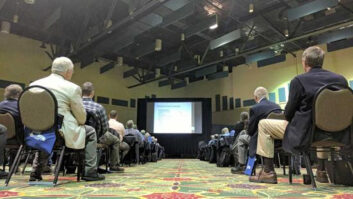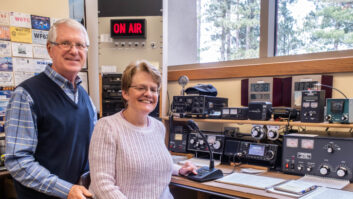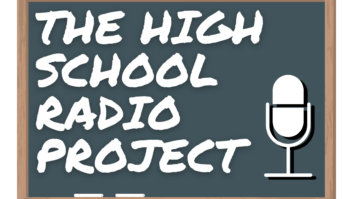
Salesman Dick Witkovski
Credit: Photo courtesy Dick Witkovski In an earlier issue we related a story about the career of Dick Witkovski, who has been in the business for 58 years as on-air talent, salesman, station owner and consultant. Here we look at another colorful part of his history.
Offshore broadcasting is not in Dick’s Witkovski’s blood, but he did have an excuse when he became involved. Witkovski lived two streets over from radio engineer Glen Callison in Dallas, Texas. They were friends when Callison hired on with an offshore broadcaster. One thing led to another, ultimately resulting in the sale of some broadcast equipment.
Witkovski sent a 10 kW AM transmitter to an offshore station that “almost” made it to the air. It was intended to broadcast music commercially to England and Ireland in about 1960, located in the Irish Sea, offshore near the Isle of Man. The process had several hiccups — the first transmitter was dropped accidentally and sank in the ocean. This occurred as it was being hoisted onto an abandoned World War II gun platform.
Naturally, Witkovski had to find yet another transmitter for them. Even with the replacement, the station never successfully broadcast because it was discovered that the gun platform was not actually in international waters. British authorities, using legal proceedings, reportedly demolished the equipment.

The Radio Caroline ship is shown. Note its 300-foot tower.
Credit: Photo courtesy Dick Witkovski Witkovski also went on to supply another group of offshore broadcasters with a new Continental 316B 10 kW AM transmitter. The result was Radio Nord, owned by Gordon MacLendon and Clint Murchison Jr. The station was hosted aboard a ship anchored near Stockholm, Sweden, in the Baltic Sea. It took to the air in 1961 after several incidents of storm damage at sea. In 1962, only 14 months after first signing on, the ship lost its anchor in a storm and had put to port for more repairs, and at that time, a new Swedish law required a final shutdown.
CODED CONVERSATIONS
Irish businessman Ronan O’Rahilly showed unbridled enthusiasm to be an offshore broadcaster. His dream became a reality with Radio Caroline in 1964, broadcasting aboard an anchored ship in the North Sea, near England.
Listeners found it on 1520 kHz via two 10 kW transmitters combined for 20 kW into a tower at the bow of the ship.
According to Witkovski the best part about broadcasting over the ocean is the advantage that the electrical conductivity of seawater is about 5,000, compared to 1 to 40 on land, which meant they had no problem getting a signal to land.
One challenge of this work, Witkovski says, was that O’Rahilly was concerned their telephone conversations might be overheard by authorities. To confuse potential eavesdroppers, O’Rahilly referred to transmitters as “trucks.” For example, he wanted a truck that would “go 50 miles per hour,” translating to 50 kW. Witkovski complied with this request, and the station’s power was increased to 50 kW, serving 20 million people. Radio Caroline had more listeners in 1964 than the three British Broadcasting Corp. networks combined, Witkovski remembers.

50 kW RCA Ampliphase transmitter on Caroline
Credit: Photo courtesy Dick WitkovskiROUND TWO
Caroline’s anchor chain broke in 1980, and the ship sank, ruining all the equipment aboard. Radio engineer and part time announcer Peter “Chicago” Murtha was sent to the United States to pick up a replacement transmitter, again supplied by Witkovski.
It was a 50 kW RCA Ampliphase, which could modulate to 150 percent positive. This was a real plus to get a loud sound on the dial, Witkovski notes. The new Radio Caroline ship was equipped with a 300-foot tower, taller than the ship was long. Tons of ballast were used near the ship’s keel to counterbalance and stabilize the pendulum effect of the tower. Radio Caroline was back on the air in 1983 at 963 kHz, later heard on 558 kHz.
Then another disaster struck. In 1991, the ship’s anchor chain broke again and she drifted near shore, grounding, and this time almost sank.
This chapter of the station’s history ended, though today you find Radio Caroline on the Web at http://carolinestreams.weebly.com.
OFFSHORE VS. PIRATES
Witkovski takes pains to differentiate offshore vs. pirate broadcasting.
Offshore broadcasters operate in international waters. In the early 1960s, he said, offshore broadcasting became a method for commercial radio to make a breakthrough into Europe and Scandinavia, where no commercial frequencies were available and there were no country licenses to apply in international waters; the law did not prohibit broadcasting from international waters. Pirates, on the other hand, operate illegally from within the countries to which they broadcast.
MORE OFFSHORE AAAARGH
Find further information at www.radiocaroline.co.uk.

RW has also reported on an interesting Radio Caroline smartphone app.
AM was the logical choice as broadcast medium because the coverage was better, and there were more AM radios in the hands of potential listeners. FM, back then, meant “Free Music.”
Witkovski says this type of broadcast was experimental, and he found it to be an adventure, an opportunity to expand commercial radio to countries where that kind of broadcasting was not available. The experience was grounded in the hope that all governments would someday issue commercial licenses because there was—and is — a need for it.
Mark Persons, CPBE, has more than 30 years’ experience and has written numerous articles for radio publications. He uses amateur call sign WØMH; his website is www.mwpersons.com.












